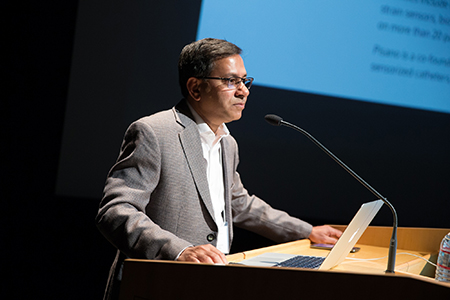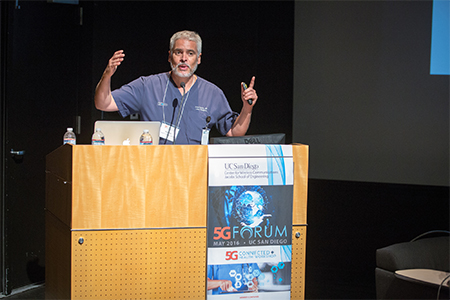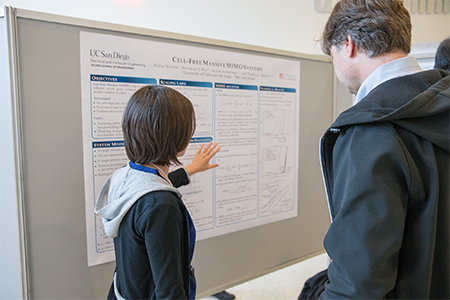Dreaming Big at the 5G Wireless Forum and Connected Health Workshop
Published Date
By:
- Tiffany Fox
Share This:
Article Content

Sujit Dey, Director of the CWC at UC San Diego. To see more photos from the 5G Forum, click here. Photos by Alex Matthews, Joel Polizzi and Anna Liza Smith for QI.
The latest technological advance to excite not only computer engineers but business executives and physicians is…. a set of telecommunications standards?
Technically, yes. But it’s the potential offered by 5G (fifth generation) wireless – the standard emerging as a replacement for 4G – that has everyone talking. And talking big.
“To me, 5G is really our first opportunity for a network not defined by numbers, but built for experiences that we have not seen before – not just good audio or video experiences, but life-changing experiences, similar to what the Internet provided when it first arrived,” says Electrical Engineering Professor Sujit Dey, Director of the Center for Wireless Communications at the University of California, San Diego and the organizer of the CWC’s 5G Wireless Forum, which was held recently at the University’s Atkinson Hall.
“Every ‘G’ enabled something different,” Dey continues, “but a lot of us believe 5G may enable what past standards could not, all kinds of bold applications that we can’t imagine today. Although increases in speed, capacity, and other metrics are of course a focus of 5G, I will be disappointed if the primary focus is on numbers. 5G is not just about speed and throughput, it’s also about enabling an Internet of Things (IoTs), with trillions of sensors communicating zettabytes of actionable data, and massively distributed analytics on billions of edge and cloud devices, all driving new paradigm-shifting services. If today is the 4G era, and we are at a user experience index of 10, I would like 5G to be at 99 or 100 – a ten-fold increase in the kinds of experiences we are having now.”
In other words, to make 5G a reality, sensing, computing and communications must converge and transform wireless networks into intelligent, efficient and flexible drivers of a world where, as one speaker put it, “every day things get connected for a smarter tomorrow.”
[To see more photos of the 5G Forum, click here.]
About 150 experts from industry, academia and government attended the two-day forum, which was preceded by a daylong Connected Health Workshop focused on the medical applications of 5G.
Dey, who joined Jacobs School of Engineering Dean Albert Pisano to kick off the series, noted that both the Connected Health Workshop and the 5G Forum often serve as a guiding force for academic research emerging from the CWC as well as UC San Diego on the whole.
Dey says the researchers at the CWC “look toward these events to determine how we can preserve our core strengths in circuits, signal processing, networking and multimedia research,” but also how to “nurture and expand leveraging those strengths into new, exciting directions” such as Industrial Internet of Things (IIoTs), Smart Cities, virtual and augmented reality and one of the most pervasive topics of conversation among the visitors to the Atkinson Hall auditorium that week: Connected Health.
At the Connected Health Workshop, Dean Pisano called the CWC “a collaborative hub” and pointed out that the Jacobs School of Engineering is the largest engineering school in California and now has six joint-faculty appointments with the UC San Diego School of Medicine.
“The Jacobs School has made a commitment to Connected Health,” said Pisano, “and San Diego is the perfect place to lead this revolution. We’re able to build the wireless sensors, the data analytics, the machine learning models that will integrate into a multi-level multi-model system and bring us from information to knowledge. UC San Diego, because of the CWC, has one of the most influential, important, and powerful body of industrial connections of any center in this school. All the right pieces are here.”
These collaborations are important, says Dey, because the data-intensive future of medical treatment (which will increasingly depend on the sensing, analysis and modeling of human pathologies) requires that networking experts understand the needs of those in the medical field, and that physicians understand the constraints of the technologies they hope to use.
But Connected Health is just one of what Dey calls the “significant disruptions” that are expected as a result of 5G technologies. The 40 speakers at the 5G Forum – including keynote speaker and leading mobile industry strategist Chetan Sharma, Vice President of Research at Samsung, Charlie Zhang, and Principal Researcher/Manager Haralabos Papadopoulos of NTT/DOCOMO – described a number of other advances expected in the areas of 5G systems, applications and circuits.
On the technical end, the challenges of providing enough spectrum to accommodate the many demands on 5G networks was the subject of much discussion during a session on multiple frequency bands, accesses and cells. Speakers from Mitsubishi Electric Research Laboratories, Keysight Technologies, Qualcomm, NEC Labs and Nokia tackled the challenges and opportunities of multiple frequency bands. Massive Multi-input, multi-output (MIMO) technology, for example, is revolutionizing wireless broadband by equipping cellular base stations with a massive number of adaptable antennae that can either receive or transmit signals, thereby maximizing the possible number of signal paths and increasing data rate and reliability. The move toward high frequency signals – in the millimeter-wave band (mmW) -- extremely high radio frequencies (30 to 300 GHz) – is providing more bandwidth to deliver faster, higher-quality video and multimedia content.
A session on 5G Circuits featured a number of professors from UC San Diego, including Electrical and Computer Engineering Professors Peter Asbeck, Ian Galton and Gabriel Rebeiz, as well as Assistant Professors Drew Hall and Patrick Mercier, who discussed high-efficiency power amplifiers and transmitters for 5G applications and the ultra-low-power wireless sensors and radios expected to power IoTs, among other topics.
Hall also spoke at the Connected Health Forum on Mobile Point-of-Care (POC) Diagnoses enabled by the mobile-phone based POC biosensor he and his team have developed. Similar to a disposable pregnancy test, the device (which is compatible with the estimated 5 billion mobile phones around the world that have an audio jack) is capable of sensing and analyzing a range of health data, including, in one instance Hall mentioned, the sputum coughed up by a patient with cystic fibrosis.
“The sputum tells us something about the microbial community inside the patient, which is indicative and predictive of overall health,” said Hall. “What if this technology was already in our smartphones? What if, like the camera, this was standard technology that we’d come to expect? I think this is what 5G really enables. It moves us much closer to (Star Trek creator) Gene Roddenberry’s vision of having a Tricorder, and not just for discrete time samples but continuous samples. 5G technology is making healthcare more portable and more personalized. Wearable sensors are positioned to be our first line of healthcare.”
Another panel at the 5G Forum focused on the 5G application for virtual reality. Alex Hern, CEO and Founder at Tsunami VR said his company aims "to be at the intersection of art and science” and added “in order to get people to use the different virtual reality platforms, we have to tell a story, we have to make things beautiful for the consumer.”

Ariel Ortiz Lagardere
Dr. Ariel Ortiz Lagardere, Medical Director and Director of Bariatric Surgery at Tijuana, Mexico’s Obesity Control Center, spoke passionately about VR in medicine, surgical training “and beyond.”
“You know what I need?” he asked the audience. “I need virtual-reality surgical streaming. I want to go live. In (surgical training), recordings work, but live is where it’s at. That’s where lives really matter. This will help others in the future be better than me. That’s where VR is right now, and that’s where it will be in the future.”
To underscore the point, Praveen Gupta, Vice President of Corporate Investments and Development for HTC, showed a video depicting physicians investigating an aneurysm in real time using a head-mounted device called the HTC Vive. Dey, also a speaker on the panel, noted that while physicians are moving toward a “truly mobile VR experience,” they are limited by current VR devices, which are often encumbered by weight and wires.
“Otherwise you are using something like Oculus Rift or Samsung Gear, but they are very clunky,” continued Dey. “My dream, which I think is not going to be that far off, is lightweight VR glasses with a small decoder chip and an antenna with high bandwidth and lower power than what Bluetooth can do. If we can get this, I would like to create an experience where all the rendering and everything is going on in the cloud.”
But, Dey points out, rendering imagery in the cloud does not always make for the smoothest user experience.
“Those working with cloud know that even cloud-based gaming and other apps needs tremendous amounts of bandwidth. VR head-mounted devices make the requirements much steeper because user experience is much more sensitive to visual artifacts and head motion significantly increases latency sensitivity.” Dey added that cloud based wireless VR requires high video quality and resolution, and with head motion, very high frame rate (which maybe limited today by compute capabilities), leading to very a high video bit rate to enable a good user experience.

Massive Multi-input, multi-output (MIMO) technology, for example, is revolutionizing wireless broadband by equipping cellular base stations with a massive number of adaptable antennae that can either receive or transmit signals, thereby maximizing the possible number of signal paths and increasing data rate and reliability.
“We have to look at this kind of video in multiple dimensions both in terms of content motion and head motion, and look at new ways of optimizing” he said.
Associate Professor of ECE Tara Javidi of UC San Diego noted that she and her CWC colleagues are working to create “the plumbing that everyone seems to be ordering here,” in other words, hybrid networking techniques for low-latency, media-rich applications.
“More and more these networks will be a really complicated hybrid of networks, but will need an interface that virtualizes and automates the applications while still allowing them to ‘talk’ to one another,” she continued. “These are the challenges that are posed to a 'plumber' like me. Beyond virtualization we need to optimize network quality and optimize it so it matches the requirements for each bit. The question is how should I stitch all of these things together to provide a pipeline that does the job for you, given that different pieces have variable costs per bit. We need to manage this congestion in a smart way and segregate traffic based on requirements and match it to network characteristics.”
But when it comes to transforming the 5G network to accommodate the many applications, circuits and systems being envisioned by end-users, speed is of the essence. Jonathan Wood, a senior director of Market Development and 5G Partnerships for Intel’s Communications and Devices Group, perhaps said it best: “The train has left the station. Tomorrow’s 5G is going to be created today. We are looking at the whole of 5G end-to-end and ensuring that the tech is the right size, right power and performance for the devices of 2019.”
Share This:
You May Also Like
Stay in the Know
Keep up with all the latest from UC San Diego. Subscribe to the newsletter today.



